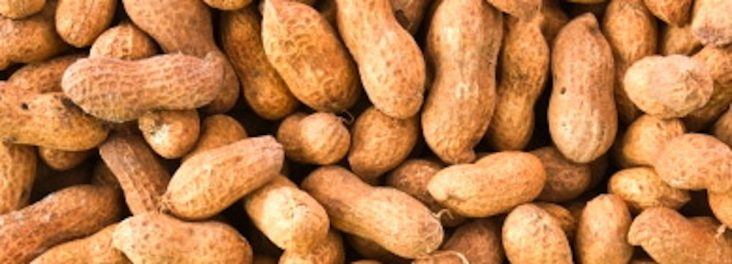Arkansas farmers hope to harvest bumper peanut crop in 2016
by November 7, 2016 7:31 pm 636 views

Arkansas farmers could have their largest peanut harvest in the last five years, and a slight bump in prices may help some row crop farms decimated by heavy rains in August.
The University of Arkansas Division of Agriculture estimates more than 22,000 peanut acres were planted this year, a 22% increase from the state’s previous high 18,500 acres planted in 2012.
Since the crop was reintroduced to the state in 2011, Northeast Arkansas farmer Greg Gill has planted more peanuts than any other farmer in the state. Gill, who will serve as president of the National Peanut Board in 2018, said prices in the spring hovered around $355 per ton, but some contracted prices rose to $425 per ton in recent months.
“The prices are better than we expected, that’s for sure,” Gill told Talk Business & Politics. “A lot of it depends on the contracts, but overall this is better than what was projected, for sure.”
Gill typically grows up to 1,500 peanut acres each year, but in 2016 he reduced his acreage to 1,040. Prices have ticked up slightly, and Gill thinks peanut field yields will also be higher in Arkansas than the national average. The national average per acre is 3,500 pounds, he said. His fields have garnered more than 4,200 pounds of peanuts per acre, and he thinks most Arkansas farmers will hover in the 4,000 pound range, he said.
AN ODD YEAR
Thousands of rice and soybean acres were lost in state after the unrelenting rains in late summer. Gill lost several hundred acres of soybeans and rice along the Black River bottoms, he said. A better peanut crop will help offset those losses, he said.
University of Arkansas Division of Agriculture Lawrence County Extension Chair Herb Ginn said the August rains did depress yields in some fields in Northeast Arkansas. Harvest weather has been excellent, and has helped significantly, he said. He estimates more than 90% of the peanut crop in NEA has been removed from the fields. Exact harvested acreage totals won’t be available until December.
“This year has been odd to say the least … the weather has fluctuated in ways we haven’t seen it do in a long time, maybe ever,” Ginn said.
Peanut prices have fluctuated wildly since the crop was revived in the state five years ago. At one point in 2011 some farmers were paid as much as $1,000 per ton, but at other times the price dropped into the $350 per ton range. Despite the market gyrations, the crop has become a staple crop in NEA.
Birdsong Peanuts opened a buying point in Portia in 2012. The buying point can process and store about 15,000 acres worth of peanuts, according to the company. This year the company built a third drying shed, and the company has had to rent buildings in Jonesboro to store the high protein legumes.
Talk Business & Politics has learned Birdsong plans to build another warehouse at the Portia facility in 2017. Birdsong will have to pass an Arkansas Department of Environmental Quality review before the warehouse can be approved.
ARKANSAS’ PEANUT PRODUCTION HISTORY
Arkansas was a peanut producer up until the early 1980s. Peanut production shifted to other states like Georgia, Oklahoma, and Texas. Growing conditions and soil were two main reasons why the legume grew better in other states. It takes peanuts about five months to grow, and the plant prefers sandy soil. At the end of the process, peanuts have to be “turned” in the field, exposing them to wind and sun. This helps to dry the nuts before the harvest.
Northeast Arkansas has sandy soil in some areas, especially in Lawrence, Craighead, Mississippi, and other counties, but farmers are leery about the fall weather in the region. It often turns cold in the area during the peanut harvest which can hurt yields. During the turn process rains can damage the crop and it’s a concern, Ginn said.
Peanuts rotate well in cotton fields. Once the viability of the crop is demonstrated, many think cotton farmers in the Mississippi Delta could turn to peanuts as a rotation crop, Ginn said.
Georgia is the top peanut producing state in the country, with more than 730,000 planted acres this year, nearly 46% of the country’s total peanut acreage, according to the USDA. The legume has a $2 billion domestic retail market. It’s the 12th most valuable cash crop in the country, with a farm value of $1 billion in 2013, according to the American Peanut Council.
The United States grows about 10% of the world’s peanuts, about 29 million metric tons, according to the American Peanut Council. It’s the third largest peanut producer in the world, trailing only China and India. Each year the U.S. exports up to 250,000 metric tons of peanuts.
Arkansas was recognized as a major peanut producer in 2014. Gill was shocked he was nominated to preside over the National Peanut Board in 2018. Gill will increase his peanut acreage to almost 1,300 in 2017, he said. He hopes prices rebound further in the coming year.
“Well, obviously I’m humbled and honored to serve on the board,” Gill said. “It’s nothing I expected. I think peanuts are a sustainable crop in Arkansas. We’re going to do everything we can to make sure that happens.”
